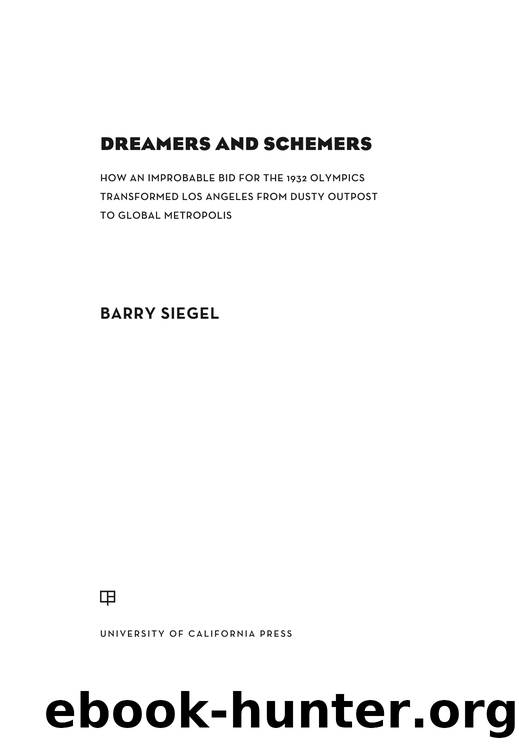Dreamers and Schemers: How an Improbable Bid for the 1932 Olympics Transformed Los Angeles From Dusty Outpost to Global Metropolis by Barry Siegel

Author:Barry Siegel [Siegel, Barry]
Language: eng
Format: epub
Tags: History, United States, 20th Century, State & Local, West (AK; CA; CO; HI; ID; MT; NV; UT; WY), Sports & Recreation, Olympics & Paralympics
ISBN: 9780520970649
Google: RxGnDwAAQBAJ
Amazon: B07WKVPCW5
Publisher: Univ of California Press
Published: 2019-10-04T00:00:00+00:00
The women’s track and field trials, held at Northwestern University in Evanston, Illinois, drew the most attention of all. In legendary fashion, Babe Didrikson, twenty-one then, entered eight of the ten events, won five outright, and tied for first in a sixth, the high jump—piling up enough total points by herself in one day to win the national team championship and the enmity of some fellow athletes, who came to resent what they considered Babe’s “swaggering, me-first” attitude. The AAU rule, at the time, said each woman could enter only three events, so Babe’s competitors were both puzzled and shocked that officials allowed Babe, for some unknown reason, to enter eight. She had a press agent and photographers following her around. Like a three-ring circus, some of the young women thought.
There was no disputing that Babe could be abrasive. With determination, she had pulled herself up from a hardscrabble background. Five feet five and a half inches tall, she was physically strong and made no attempt to hide her abilities. Born in Port Arthur, in southeastern Texas, she at age four moved with her parents and six siblings to Beaumont. The family was not well off, but her father built a makeshift gymnasium in their backyard, and before her teens Babe already knew she wanted to be the greatest athlete that ever lived. She claimed to have acquired the nickname “Babe” after hitting five home runs in a childhood baseball game, but in truth her family always called her “Baby,” and that eventually evolved to “Babe.” In high school she starred on the girls’ basketball team, making all-state, then landed a position as secretary for the Employers Casualty Insurance Company of Dallas, where her real job from the start was to play basketball on the company’s amateur team, the Golden Cyclones, which she led to an AAU basketball championship in 1931. By then, she was already drawing even wider attention for her feats in track and field.
In fact, the commotion over her had started with her first track titles in 1930 and seemed to affect her. At the 1931 nationals in Jersey City, she arrived with a retinue and a cocky, unfriendly manner. By the time of the 1932 AAU national meet, she had become crabby and demanding, close to unbearable, alienating other athletes. All the same, newspapermen lionized her, giving her more and more coverage.
The hurdler Evelyne Hall first encountered Babe at the women’s 1930 outdoor national championships in Dallas. It was a broiling hot Fourth of July. Evelyne won the hurdles there, placed in the broad jump, and started on the winning relay team. She thought Babe, at the time, was a good-natured if boastful girl. She did not imagine competing against her or anyone else in the Olympics, because the hurdles was not yet an Olympic event for women.
Still, Evelyne stuck with it, scraping together gas money to drive through blizzards to the 1930 indoor championships in New Jersey, where she won again, setting a new record in the fifty-meter hurdles.
Download
This site does not store any files on its server. We only index and link to content provided by other sites. Please contact the content providers to delete copyright contents if any and email us, we'll remove relevant links or contents immediately.
The Inner Game of Tennis by W. Timothy Gallwey(3479)
Unstoppable by Maria Sharapova(3409)
Urban Outlaw by Magnus Walker(3246)
Crazy Is My Superpower by A.J. Mendez Brooks(3207)
Mind Fuck by Manna Francis(3040)
The Social Psychology of Inequality by Unknown(2770)
The Fight by Norman Mailer(2709)
Unstoppable: My Life So Far by Maria Sharapova(2387)
Accepted by Pat Patterson(2219)
Going Long by Editors of Runner's World(2215)
Futebol by Alex Bellos(2138)
The Happy Runner by David Roche(2125)
Motorcycle Man by Kristen Ashley(2116)
Backpacker the Complete Guide to Backpacking by Backpacker Magazine(2111)
The Sports Gene: Inside the Science of Extraordinary Athletic Performance by David Epstein(2064)
Sea Survival Handbook by Keith Colwell(2044)
Peak: Secrets from the New Science of Expertise by Anders Ericsson & Robert Pool(1927)
Endure by Alex Hutchinson(1873)
The Call of Everest by Conrad Anker(1788)
